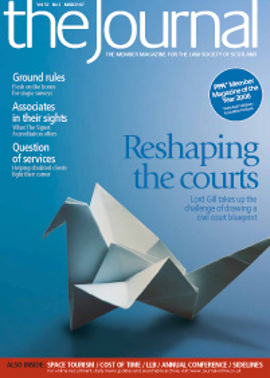Signet badge takes wing

Accreditation equals specialist, equals applying to the Law Society of Scotland. Nice and simple?
Well, the Society of Writers to HM Signet has other ideas. Not that it has anything against the Law Society’s scheme, but it does believe there is a need, and demand, out there for both a different approach and a different level of assessment of your expertise as a solicitor. The announcement in late January of a distinguished board to supervise the “The Signet Accreditation” signalled that the WS Society’s own programme will soon open for business.
But why the need for a separate scheme? Chief executive Robert Pirrie has led the project for the past 18 months, working from similar models operated in Australia over the past 15 years or so – even borrowing Eliza Letsch, specialisation assistant at the Law Institute of Victoria, to help him in the task. He points to two fundamental differences in approach.
Assessment basis
First up is the nature of the recognition process. “Around the world there are two types of accreditation schemes, very broadly. There are schemes that are based on peer recognition, and there are schemes that are based on assessment. The Law Society scheme is based largely on the principle of peer recognition: candidates are vetted by the committees for the practice area, they are recognised if you like by their peers as being expert. We felt that what we wanted to set up was a scheme based on assessment, which is the other principle.”
The proposed method of assessment highlights the other key difference. The Signet Accreditation’s focus on developing practical expertise and a client focus. “We’re not only assessing, examining people’s knowledge of substantive law and practice”, Pirrie explains. “We’re putting an equal emphasis on client focused skills, communication skills, relationship skills, efficiency, and relevance and proportionality of advice. Traditionally, and the Law Society of Scotland scheme is not unique in this, in other jurisdictions including Australia the emphasis is very much on technical knowledge and skill. We’re building on that and putting an equal emphasis on assessing things that are important to clients about lawyers, rather than just those things that are important about lawyers to other lawyers.”
Candidates will have to be alert to ethical issues too. “Everything that we want to assess, we want to assess holistically, in an integrated way: in other words the lawyer will be presented with a scenario that is not identified for them as an ethical problem, but there may be an ethical problem buried away, just as in practice the client doesn’t come in saying ‘I’ve got an interesting conflict for you’.”
Your standardised client
Conceding that it has been a challenging task to devise a suitable assessment regime, Pirrie and his team have come up with a three-stage test – examination, take-home assignment and a practical performance-related test. The first two will involve exercises like writing a letter to a client for a particular situation, or a memo to a partner or superior, with the aim of reflecting actual work-related scenarios. For the practical assessment, they are developing the use of a simulated interview with a “standardised client”. Deriving from the “standardised patient” adopted by the medical profession in the United States, the candidate will be recorded interviewing someone playing the role of the client, “briefed very thoroughly and also briefed and trained in the assessment”.
“You’re right that there’s a lot of work, but the methodology for this has all been designed and proven. There’s a published paper on a pilot project that Glasgow Graduate School of Law ran in partnership with the Georgia State University College of Law, and Professor Clark Cunningham of the College of Law is working with us as a consultant on our scheme.”
Pirrie and his colleagues are very serious about the client service element. “There are areas where in a sense the client is always right. If a client says the lawyer didn’t listen to them, then in some senses the client is right, whether or not the lawyer thinks they have listened. If the client comes away with the feeling that the lawyer didn’t listen, or didn’t give the client the opportunity to say what the client wanted to say, the client may be the best judge of that, and that’s what we want to try and build into particularly the simulated interview type of assessment.”
Associates forward
Crucially, despite appearing at first sight to set a sort of gold standard for solicitors, The Signet Accreditation scheme is targeted slightly below the level of most other schemes, at home and abroad.
“There’s a model that’s used in professional development called the Dreyfus model, it’s not unique to the legal profession, which defines competency in five levels: novice, advanced beginner, competent, proficient and expert. We’re going for level 4, “proficient”, and the significance is that the average age of those who will be accredited under our scheme will, I think, be younger than under the Law Society scheme, which would typically be more at the expert level. We think people would be ready for this around about the five years qualified point in their career, associate level, just at that point when a lawyer is beginning to work with, or is expected to work with, minimal supervision.”
Pirrie relates a trend that has become apparent in Australia, an increasing demand both from younger lawyers and from some of the larger firms that the schemes there would be more relevant to them if lawyers could go for accreditation at an earlier stage in their careers. Having done some market research in Scotland, he is sure a similar demand exists here.
“The expression used by a partner in one of the larger firms was ‘outsourced assessment’. The larger firms have their internal training and internal career development, but what’s of interest to them is some form of objective and independent assessment.”
In other words a benchmark by which they can assess candidates for promotion? “Exactly, and it also allows them to be doing something for their lawyers in the sense of supporting them to get this qualification, which will be something that a lawyer will have on their CV independently of the law firm or the law firm’s brand. So there’s an employee development, employee benefit side to it, and from the bigger firm’s point of view an associate retention issue there as well.”
From then for life
It may come earlier, but another of The Signet Accreditation’s stated aims is encouraging lifelong learning. How does that square with an assessment at five years’ pqe? CPD, says Pirrie, both before and after assessment. Before assessment, he believes potential candidates will aim to structure their CPD towards attaining the accreditation; once they have it, the scheme’s own CPD requirements “will exceed those of the Law Society both in terms of number of hours and in particular the number of hours that have to be spent in the practice area itself”.
Although at an advanced stage of preparation for its planned October launch, the scheme (to be open to all Scottish solicitors, not just WS Society members) will not be aiming across the board in terms of practice areas from the outset. Commercial property and commercial litigation will be first off: practice area committees for each have already been meeting since the autumn and are well on with formulating the assessment criteria. Pirrie aims to establish about 14 or 15 practice areas in due course, again similar to the Australian model but differing from the 20-odd already offered by our own Law Society.
“We’re deliberately pitching them reasonably broad, and that’s because one of the things that we want to reflect, and indeed assess, is a lawyer’s ability to put things into a broader context, and therefore to some extent redress the imbalance that you can get with very narrow and deep specialisation early in a lawyer’s career. From a client’s perspective what that can sometimes mean is that the lawyer can’t set the thing in a broader context, and that’s why we’re picking practice areas that are reasonably broad.”
Cultural revolution
Pirrie claims much interest in the WS initiative from other jurisdictions, not least through its pioneering of a scheme at the pre-expert level: many states in the US are watching closely. It also has something to do with his placing client communication skills at the heart of modern practice. “It isn’t an excuse to say, I’m a lawyer in so-and-so and you don’t need to be particularly effective at explaining things to clients if you’re in that area. We’re really saying things are moving on, and no lawyer can shelter behind the fact that they’re an expert in the field if they can’t communicate effectively.”
He does not shrink, indeed, from claiming that the WS Society is “changing the culture of how lawyers think – client impressions are fundamental”.
If the Scottish scheme in turn becomes the benchmark for others, the claim will be well justified.
The Signet Accreditation is operated by The Signet Accreditation Limited, a limited liability company (SC270595). “The Signet” and associated logos are used under licence from The WS Society (The Society of Writers to Her Majesty’s Signet), a corporate body under the laws of Scotland.
For enquiries, contact Eliza Letsch, Accreditation Manager, on 0131 225 0652 or eletsch@thesignetaccreditation.co.uk
VIVE LA DIFFERENCE, SAYS LAW SOCIETY
The Law Society of Scotland has welcomed the emergence of The Signet Accreditation. Neil Stevenson, Deputy Director, Education and Training, commented to the Journal:
“We’re pleased to see this scheme being launched. It clearly demonstrates how seriously the entire profession takes maintenance of standards and continuing development, having been established by an independent group of practitioners outside the formal regulatory structure and being entirely voluntary in nature. It should assist solicitors, by being part of their approach to achieving the current, and future, standards set by the Society. We also believe it compliments our own specialist accreditation scheme, which targets a later career stage than the WS Society’s model.”
THE SIGNET ACCREDITATION: ASSESSMENT GUIDELINES
PRINCIPLES
Definitions of level of expertise and constituent elements of expertise.
Level: The ability to undertake the range of work that would reasonably
be regarded as routinely falling within the responsibility of a solicitor in the particular practice area, and to do so with minimal or no supervision, proficiently, effectively, efficiently and ethically.
Elements: Technical; Client and context-focused; Practice management; Ancillary (e.g., industry sector); Ethical.
Each underlined expression explained in full version.
CONTENT
Contains for each practice area:
- Statement of expertise and tasks a solicitor will be required to demonstrate (e.g., by subject, process, transaction or otherwise).
- Statement of method of assessment, including format of assessment.
EXAMPLE
From Commercial Litigation
“DETERMINING STRATEGY
a) Gather and marshal information.b) Confirm view of applicable law and jurisdiction.
c) Consider whether dispute resolution is already subject to an agreement.
d) Consider reputational and public relations issues.
e) Develop strategy.
f) Consider and identify practical consequences.”
Extracted from Assessment Guidelines
© The Signet Accreditation Limited 2007
In this issue
- A look in the mirror
- A welcome review
- Squaring the circle
- Profitability and financial structure
- Access-ability
- Culture change
- Practice? What practice?
- Signet badge takes wing
- Four in one
- Appreciation: Angus McLean
- In on the Acts
- "Lossiemouth, we have a problem"?
- Flagging up VAT
- In the family way
- Practice inside out
- Shape of things to come
- Breaking down a brick wall?
- Playing by the rules
- Scottish Solicitors' Discipline Tribunal
- Website reviews
- Book reviews
- Funny thing
- PIPs' hour approaches
- Enabled in the housing market
- Registers refresher






